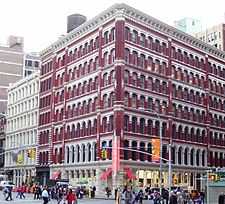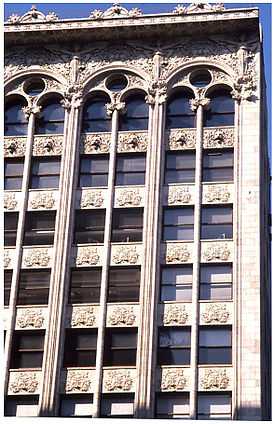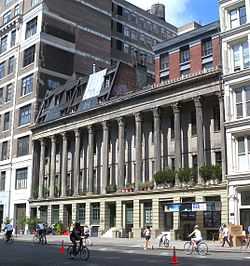NoHo, Manhattan
Coordinates: 40°43′43″N 73°59′33″W / 40.72863°N 73.99253°W
NoHo, for North of Houston Street (as contrasted with SoHo, South of Houston) is a neighborhood in the New York City borough of Manhattan. It is bounded by Mercer Street to the west and the Bowery to the east, and from East 9th Street in the north to East Houston Street in the south.[1] NoHo is primarily made up of loft apartments, which in turn makes it one of the most expensive and desirable neighborhoods in Manhattan. Its small size and central location also contributes to a high demand, again keeping prices high.[1]
The Landmarks Preservation Commission has declared most of it a 125-building historic district,[1] divided into the NoHo Historic District[2] and the NoHo East Historic District, created in 2003.[3]
History
When Lafayette Street was opened in the 1820s, it was one of the most fashionable streets in New York: the only survivor of that era is half of the original Colonnade Row, 1833, perhaps designed by Alexander Jackson Davis for speculative builder Seth Geer.[4][5] Across from it is The Public Theater.[6] When it was a light manufacturing and warehouse district, Robert Mapplethorpe's loft was in NoHo.[7]
Preservation

From the New York City Landmarks Preservation Commission 1999 designation report:
| “ | The NoHo Historic District, which comprises approximately 125 buildings, represents the period of New York City's commercial history from the early 1850s to the 1910s, when this section prospered as one of its major retail and wholesale dry goods centers. Acclaimed architects were commissioned to design ornate store and loft buildings in popular architectural styles, providing a rich fabric against which shoppers promenaded, looked at display windows, and bought goods, and merchants sold products. The district also contains early-nineteenth century houses, nineteenth- and twentieth-century institutional buildings, turn-of-the-century office buildings, as well as modest twentieth-century commercial structures, all of which testify to each successive phase in the development of the historic district. Today, the effect is of powerful and unifying streetscapes of marble, cast iron, limestone, brick, and terracotta facades.[2] | ” |
The NoHo Historic District was designated by the LPC in 1999 and expanded in 2008. Additionally, another district in the neighborhood, the NoHo East Historic District, was created in 2003. The designations followed considerable effort by and strong support from numerous local community and preservation groups, including the Greenwich Village Society for Historic Preservation, and together, they form a contiguous area of landmarked buildings over 21 city blocks.[3]
The 2008 extension is bounded on the west by Lafayette Street, on the east by the Bowery, on the north by East Fourth Street and on the south by Bond Street. It includes 56 buildings and a midblock parking lot to the south and east of the existing Noho Historic District. Historically, this area was an enclave for well-to-do families.[8] Most of the buildings in the extension were built between the 1860s and the early 1900s, when the area had become one of the city’s major commercial and manufacturing districts. By the late 1800s, larger commercial lofts became the dominant building type and in the 1950s artists began to move into studio spaces.[9]
Some individual landmarks in the NoHo Historic District include: the Astor Library, the Bayard-Condict Building, the Bouwerie Lane Theater, and the DeVinne Press Building. Two New York City Subway stations, Astor Place and Bleecker Street, are also landmarked.[10]
Just outside the eastern boundary of the Historic District is another individual landmark, the Merchant's House Museum, at 29 East Fourth Street. It is also a National Historic Landmark and is listed on the National Register of Historic Places. Both the inside and outside of this 1832 house have been restored to the mid-19th century style in which merchant Seabury Tredwell and his family lived. Despite the fragility of the structure, in April 2014 the New York City Landmarks Preservation Commission approved construction of an eight-story hotel immediately next door.[11] Preservationists including City Councilwoman Rosie Mendez, the Greenwich Village Society for Historic Preservation, and the Museum itself fought the proposed hotel for years due to concern for the intact survival of the Merchant’s House.[12] The LPC approved it over the objections of engineers and architects.
Gallery
-

The Bouwerie Lane Theater's Bowery facade
-

Facade of Louis Sullivan's Bayard-Condict Building (built 1897–99) at 65 Bleecker Street between Broadway and Lafayette Street
-

687–691 Broadway/250–254 Mercer Street was designed by J.A. Wood and built from 1885–88
References
- ↑ 1.0 1.1 1.2 Hughes, C. J. (July 9, 2010). "NoHo". The New York Times. Retrieved October 27, 2010.
- ↑ 2.0 2.1 New York City Landmarks Preservation Commission. "NoHo Historic District Designation Report". Retrieved 2009-05-15.
- ↑ 3.0 3.1 New York City Landmarks Preservation Commission. "NoHo Historic District Extension Map".
- ↑ Luther Harris. "Eighth Street History". villagealliance.org. Retrieved 2014-08-22.
- ↑ Kevin Walsh. "Lower Manhattan Necrology". forgotten-ny.com. Retrieved 2014-08-22.
- ↑ Kevin Walsh. "Lafayette Street, NoHo". forgotten-ny.com. Retrieved 2014-08-22.
- ↑ "How Edward Mapplethorpe Got His Name Back". nymag.com. Retrieved 2014-08-22.
- ↑ Amateau, Albert (September 17–23, 2008). "Noho flophouse flap takes a twist with hotel plan" 78 (16). Retrieved 2013-12-27.
- ↑ The Villager. "Noho district extension protects 3 more blocks".
- ↑ GVSHP. "NoHo—Individual Listings".
- ↑ "Landmarks Preservation Commission Approves Eight-Story Hotel Next Door". MerchantsHouse.org. Retrieved 13 August 2014.
- ↑ Spokony, Sam (September 13, 2012). "Hotel Project Would Damage Merchant House, Antis Warn". The Villager. Retrieved 13 August 2014.
External links
| Wikimedia Commons has media related to NoHo. |
- NoHo Historic District at the New York City Landmarks Commission
- NOHO NY Business Improvement District
- The Public Theater
- Evening Standard article about London 'Noho' controversy

